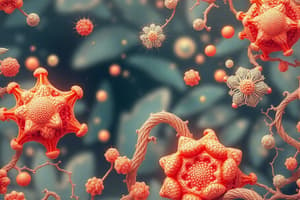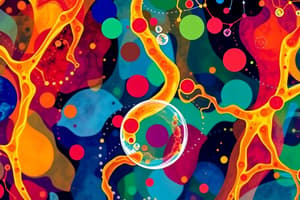Podcast
Questions and Answers
What is the primary function of proteins in living organisms?
What is the primary function of proteins in living organisms?
- Transporting oxygen
- Genetic information storage
- Structure and regulation (correct)
- Energy storage
Which of the following describes catabolism?
Which of the following describes catabolism?
- Conversion of light energy to chemical energy
- Energy release from molecule breakdown (correct)
- Storage of genetic information
- Synthesis of complex molecules
Which process converts glucose into ATP?
Which process converts glucose into ATP?
- Fermentation
- Photosynthesis
- Lipid metabolism
- Cellular respiration (correct)
What is the primary structure of a protein?
What is the primary structure of a protein?
Which type of RNA serves as the template for protein synthesis?
Which type of RNA serves as the template for protein synthesis?
What technique is used to amplify DNA segments?
What technique is used to amplify DNA segments?
Which statement is true regarding enzyme specificity?
Which statement is true regarding enzyme specificity?
What is the primary role of carbohydrates in living organisms?
What is the primary role of carbohydrates in living organisms?
Flashcards are hidden until you start studying
Study Notes
Overview of Biochemistry
- Biochemistry is the study of chemical processes within and related to living organisms.
- It combines principles of both biology and chemistry to understand cellular processes.
Key Concepts
-
Molecules of Life
- Proteins: Composed of amino acids; essential for structure, function, and regulation of tissues and organs.
- Nucleic Acids: DNA and RNA; store and transmit genetic information.
- Carbohydrates: Sugars and starches; provide energy and structural support.
- Lipids: Fats, oils, and membranes; involved in energy storage and forming cell membranes.
-
Metabolism
- Catabolism: Breakdown of molecules to release energy (e.g., glycolysis).
- Anabolism: Synthesis of complex molecules from simpler ones, requiring energy (e.g., protein synthesis).
-
Enzymes
- Biological catalysts that speed up chemical reactions.
- Specificity: Each enzyme typically catalyzes a specific reaction.
- Factors affecting enzyme activity: temperature, pH, substrate concentration, and inhibitors.
-
Cellular Processes
- Cellular Respiration: Process of converting glucose into usable energy (ATP) through glycolysis, Krebs cycle, and electron transport chain.
- Photosynthesis: Conversion of light energy into chemical energy by plants, producing glucose and oxygen.
Structural Biochemistry
-
Protein Structure:
- Primary (amino acid sequence)
- Secondary (alpha-helix, beta-sheet)
- Tertiary (3D shape)
- Quaternary (multiple polypeptides)
-
Membrane Structure:
- Phospholipid bilayer with embedded proteins; selective permeability.
Genetic Biochemistry
- DNA Structure: Double helix composed of nucleotides (adenine, thymine, cytosine, guanine).
- RNA Types:
- mRNA (messenger RNA)
- tRNA (transfer RNA)
- rRNA (ribosomal RNA)
Techniques in Biochemistry
- Chromatography: Separation of mixtures.
- Electrophoresis: Separation of nucleic acids/proteins based on size and charge.
- PCR (Polymerase Chain Reaction): Amplifying DNA segments.
Applications of Biochemistry
- Medicine: Drug development, understanding diseases at a molecular level, diagnostics.
- Biotechnology: Genetic engineering, production of biofuels, and biopharmaceuticals.
- Agriculture: Development of genetically modified organisms (GMOs) for better yield and resistance.
Importance of Biochemistry
- Understanding life processes at a molecular level.
- Application in health, industry, and environmental sustainability.
Overview of Biochemistry
- Biochemistry studies chemical processes in living organisms, merging biology and chemistry.
Key Concepts
-
Molecules of Life
- Proteins: Made of amino acids; vital for tissue structure, function, and regulation.
- Nucleic Acids: DNA and RNA; crucial for storing and transmitting genetic information.
- Carbohydrates: Include sugars and starches; serve as energy sources and provide structural support to cells.
- Lipids: Comprised of fats and oils; play key roles in energy storage and forming cell membranes.
-
Metabolism
- Catabolism: Energy-releasing process by breaking down molecules (e.g., glycolysis).
- Anabolism: Energy-requiring process that synthesizes complex molecules from simpler precursors (e.g., protein synthesis).
-
Enzymes
- Act as biological catalysts to accelerate chemical reactions.
- Exhibit specificity; each enzyme targets a particular reaction.
- Activity influenced by temperature, pH, substrate levels, and presence of inhibitors.
-
Cellular Processes
- Cellular Respiration: Process of transforming glucose into ATP through glycolysis, Krebs cycle, and electron transport chain.
- Photosynthesis: Process by which plants convert light energy into chemical energy, producing glucose and oxygen.
Structural Biochemistry
-
Protein Structure: Consists of four levels:
- Primary: Linear amino acid sequence.
- Secondary: Structures like alpha-helices and beta-sheets.
- Tertiary: Overall three-dimensional shape of a protein.
- Quaternary: Arrangement of multiple polypeptide chains.
-
Membrane Structure: Comprised of a phospholipid bilayer with embedded proteins, allowing selective permeability.
Genetic Biochemistry
- DNA Structure: Double helix formed by nucleotides including adenine, thymine, cytosine, and guanine.
- RNA Types:
- mRNA: Messenger RNA, involved in protein synthesis.
- tRNA: Transfer RNA, brings amino acids to ribosomes.
- rRNA: Ribosomal RNA, a component of ribosomes.
Techniques in Biochemistry
- Chromatography: Technique for separating mixed substances.
- Electrophoresis: Method for separating nucleic acids or proteins based on size and charge.
- PCR (Polymerase Chain Reaction): Technique for amplifying specific DNA segments.
Applications of Biochemistry
- Medicine: Essential for drug development, understanding disease mechanisms, and diagnostics.
- Biotechnology: Includes genetic engineering and production of biofuels and biopharmaceuticals.
- Agriculture: Focuses on creating genetically modified organisms (GMOs) for improved yield and disease resistance.
Importance of Biochemistry
- Provides insight into molecular life processes.
- Applications extend to health advancements, industrial innovations, and environmental sustainability.
Studying That Suits You
Use AI to generate personalized quizzes and flashcards to suit your learning preferences.




